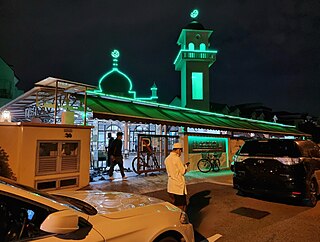
Yishun, formerly known as Nee Soon, is a residential town located in the northeastern corner of the North Region of Singapore, bordering Simpang and Sembawang to the north, Mandai to the west, the Central Water Catchment to its southwest, Ang Mo Kio to its south, as well as Seletar and Sengkang to its east and southeast respectively.

Islam constitutes the third largest religion in Singapore, with Muslims accounting for approximately 15.6% of the population, as indicated by the 2020 census. Predominantly, Singaporean Muslims are Sunni Muslims adhering to either the Shafi‘i or Hanafi schools of thought. The majority of the Muslim population, about 80%, are ethnic Malays, while 13% are of Indian descent. The remaining fraction comprises local Chinese, Eurasian, and Arab communities, in addition to foreign migrants. Buddhism and Christianity are the two larger religious affiliations in the country.

Masjid Sultan, also referred to as Sultan Mosque, is a widely known religious landmark in Singapore. This mosque, which can be found in the Kampong Glam district at the intersection of North Bridge Road and Muscat Street, is highly significant in terms of both history and culture.

Jamae Mosque is one of the earliest mosques in Singapore, and is located on South Bridge Road in the Chinatown district within the Central Area. The mosque was established in 1826. This mosque is also known as Chulia Mosque and Periya Paḷḷi among the Tamil Muslim community in Singapore. Together with its neighbour, Sri Mariamman Temple, the mosque stands out in its predominantly Chinese location. The Mosque Street that runs beside it may have been named after this mosque.

Masjid Al-Abrar is a mosque located along Telok Ayer Street in Chinatown within the Central Area, Singapore. It is one of the earliest mosques in Singapore.

Masjid Malabar or Malabar Muslim Jama-Ath Mosque, also known as Golden Dome Mosque; is Singapore's only Malabar Muslim mosque. The mosque is located at the junction of Victoria Street and Jalan Sultan in the Kampong Glam district, in the Rochor Planning Area within the Central Area. The mosque is built on the Sultan Mosque style with traditional blue and white lapis lazuli tile facade. The mosque was nicknamed as little cousin of the Sultan Mosque, because of similar golden domes.
The Majlis Ugama Islam Singapura (MUIS), also known as the Islamic Religious Council of Singapore (IRCS), is a statutory board of the Ministry of Culture, Community and Youth of the Government of Singapore. As a majlis, its role is to look after the administration and interests of Singapore's Muslim community. The Majlis is headed by a Council, in which members are appointed by the President of Singapore. Since 2009, the council is headquartered in the Singapore Islamic Hub, along Braddell Road.

Masjid Bencoolen is a mosque in Bencoolen Street, Singapore. Masjid Bencoolen can accommodate 1,100 worshipers. The mosque is co-located and integrated with a 12-storey Somerset Bencoolen serviced apartment tower.

The Abdul Gaffoor Mosque is a mosque in Little India, Singapore. It is located at Dunlop Street in the Rochor Planning Area.

Masjid Darul Ghufran is currently the largest mosque in Singapore, located in Tampines and occupying with a floor area of 5,910 sq metres. It is about 300m from Tampines Bus Interchange, and beside Our Tampines Hub.
The Abdul Aleem Siddique Mosque is a mosque in Singapore that was built as a recognition of Muhammad Abdul Aleem Siddiqi’s propagation of Islam.

Masjid Al-Abdul Razak is a mosque in Singapore, located at Jalan Ismail, off Jalan Eunos. The mosque is accessible from Eunos MRT station.

The Al-Ansar Mosque is a mosque in Singapore that was among the first few to be built under Phase One of the Mosque Building Fund Programme. It was completed in 1981 and is located in the Bedok North area, at the junction of Chai Chee Street and Bedok North Avenue 1. The mosque originally could accommodate up to 3,500 people at any one time. Apart from daily and Friday prayers, the mosque offers madrasah classes during weekdays and weekends.

Masjid Al-Iman is a mosque in Bukit Panjang, Singapore. The four level mosque building was opened on 2 May 2003 and officiated by Minister-in-Charge of Muslim Affairs Yaacob Ibrahim on 19 September 2004.

The Al-Istighfar Mosque is a mosque in Pasir Ris, Singapore.
The Al-Khair Mosque is a mosque in Choa Chu Kang, Singapore.

Masjid Taha, or Taha Mosque is a mosque in Geylang, Singapore. It is the only mosque for the Ahmadiyya Muslim Community in the country. It is located at Onan Road, adjacent to Masjid Khalid, a mainstream mosque.
Masjid Hang Jebat is a mosque in Queenstown, Singapore. It is one of the few old-generation kampung mosques left in Singapore. The mosque was iconic for its close proximity to the former KTM railway tracks.
Masjid Angullia, also known as Angullia Mosque, is a mosque in Singapore. It is a recognisable landmark of the Little India district, and a key symbol of the Indian Muslim community.
















